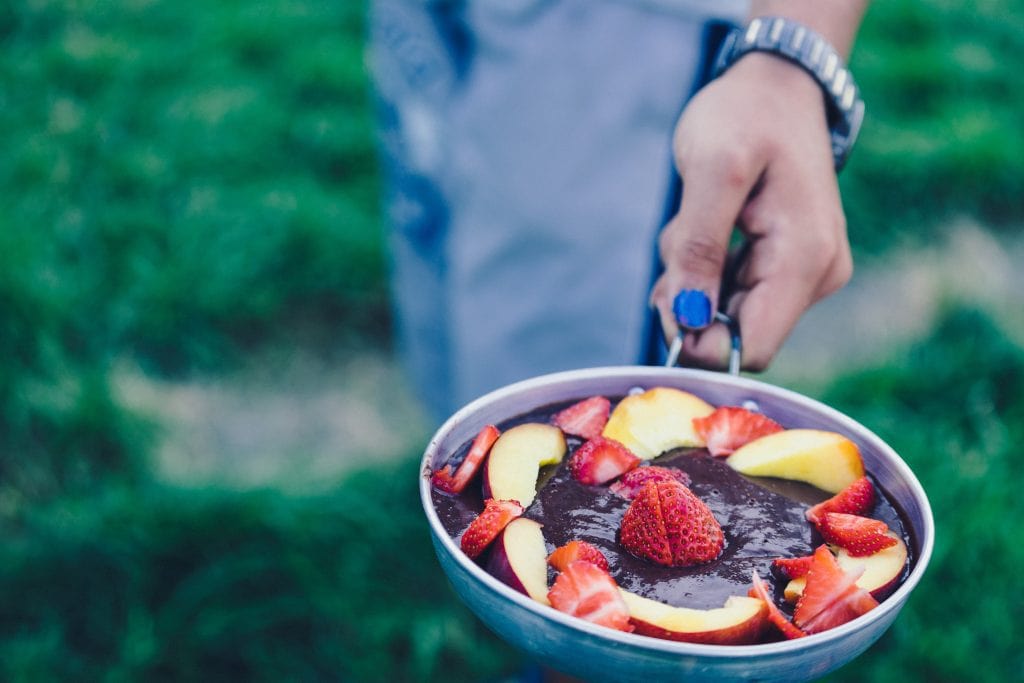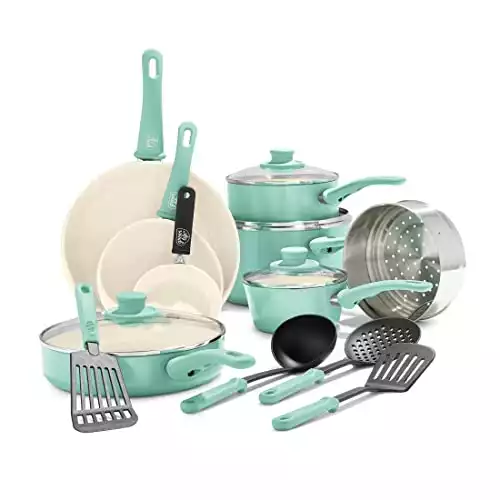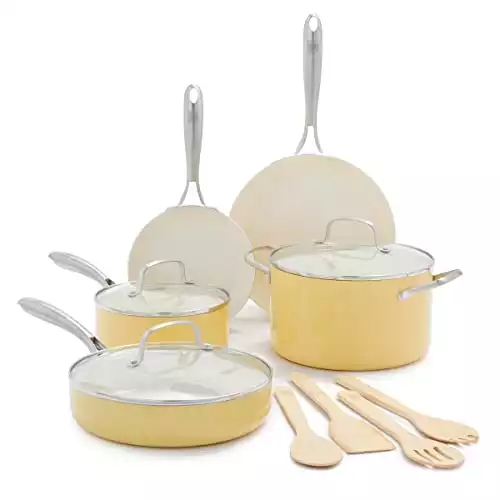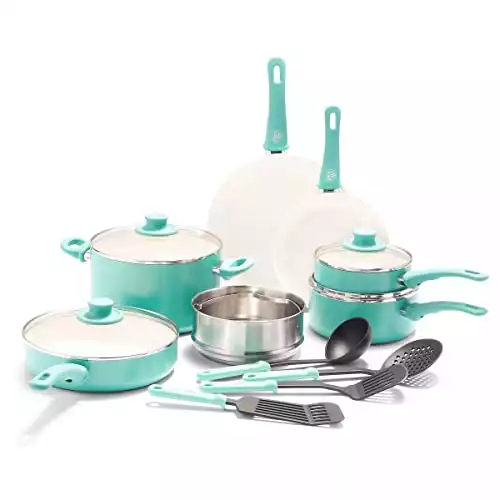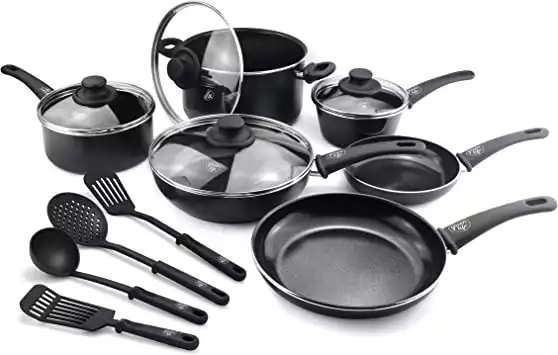If you’re just discovering GreenLife then you may have been drawn in by the brand’s vibrant color scheme, toxin-free ethos, and an affordable price point. It’s an easy way to add pop of pastel to your stovetop without breaking the bank.
Although we haven’t yet brought GreenLife into our Test Kitchen for an official trial, I’ve been a frequent user of their products over the years. They seem to be a favorite pick of Airbnb hosts, and a few of my friends.
GreenLife has several collections, but they’re all very similar in terms of how they’re built and how they perform. In this article, I’ll walk you through:
- What makes each of GreenLife’s collections unique.
- How GreenLife compares to dozens of other pans we’ve put through rigorous tests.
- Drawbacks worth considering.
- How GreenLife compares with other nonstick options.
In This Article
Comparing GreenLife Collections
All of GreenLife’s collections are designed as budget conscious options for people who want a nonstick pan without teflon. And each one is branded as eco-friendly, health conscious and chic.
The differences from one to the next are largely cosmetic, but there are a few that impact performance. This chart will provide a quick comparison of GreenLife’s cookware collections,
| Feature | Soft Grip | Soft Grip Pro | Artisan | Induction |
|---|---|---|---|---|
| Photo | ||||
| Core Material | Aluminum | Aluminum | Aluminum | Aluminum, Steel Disc |
| Non-Stick Coating | Thermolon | Thermolon + Diamonds | Thermolon + Diamonds | Thermolon |
| Non-Stick Color | White | Black | White | White |
| Handles | Bakelite | Bakelite (Ergonomic) | Stainless Steel | Bakelite |
| Lids | Glass, Bakelite Knob Handle | Glass, Bakelite Knob Handle | Glass, Stainless Steel Loop Handle | Glass, Bakelite Knob Handle |
| Color Options | 9 | 2 | 3 | Turquoise (only) |
| Induction Compatible | No | No | No | Yes |
GreenLife Soft Grip
GreenLife Soft Grip is the brand’s original model. It was introduced as a budget-friendly alternative to the company’s more expensive line called Greenpan, which we’ve reviewed elsewhere.
All of GreenLife’s other collections are essentially cosmetic upgrades on this base model, so it’s helpful to understand the Soft Grip design as a starting point. I’ve used this set nearly 100 times over the past decade. And I anticipate, given the attractive price and color options, that it will continue to pop up in short-term rentals for the forseeable future.
These pans are constructed using a pressed aluminum base, which is then powder coated with a colorful pastel ceramic on the exterior and white Thermolon ceramic on the cook surface.
What is Thermolon?
It’s a trade name for the company’s ceramic, which became popular as the first popular nonstick cookware coating to be made without using PTFE (also known as Teflon).
The handles are made from a heat resistant plastic called Bakelite, as are the knob grips used on the collection’s glass lids. And, for many people, a huge selling point of the Soft Grip set is that it’s available in 9 distinctive color ways. It’s one of the few affordable brands that offers so many attractive color options, probably inspired by Le Creuset.
GreenLife Induction
The GreenLife Induction set is an identical match to the Soft Grip collection, with one critical difference.
Although this cookware is also fashioned from cast aluminum, there is also a stainless steel disc pressed into the bottom of each pan. Why does this matter?
The primary (and intended) benefit is that the magnetic property of the steel makes this set compatible for induction cooking. None of the other collections will work on an induction stove.
There is a secondary benefit that steel adds heat retention to the pans. Aluminum is a great heat conductor, but it will fluctuate a lot if you don’t have a steady heat source. The steel in this set allows the pans to retain their temperature better, even when the heating element (or hob) fluctuates OR you add cold ingredients to the hot pan.
A few downsides of this set compared to the base model. For one, the extra material means it costs more. And the brand only offers it in Turquoise, so you don’t get the same level of color options as you would with the other collections.
GreenLife Soft Grip Pro
GreenLife Soft Grip Pro is nearly identical to the original collection, but there are a few notable updates.
The handle shape was slightly improved for better ergonomics, but still uses the same Bakelite material as the base model. Honestly, it’s not a huge difference.
The cook surface color was changed to black, as a visual distinction, and the brand made a slight modification to the Thermolon used in the nonstick coating. Specifically, industrial diamond dust was mixed with the ceramic before it was sprayed on this pan.
The diamond dust adds a micro-texture to the cooking surface, which some would argue provides an incremental benefit to the pan’s durability. In my experience, the inclusion of “diamonds” doesn’t make a huge impact on the durability of a nonstick pan.
Again, I haven’t tested this specific model, but on the dozens of diamond or granite augmented pans that I have tested, the impact of a special additive was minimal.
Soft Grip Pro is only available in Black and Turqouise, at the time of this writing.
The Artisan collection is available in GreenLife’s signature turquoise, plus two other colors that you won’t find with any of the other lines. Easter egg yellow and pink.
Like all of the other collections, the Artisan pans are constructed using a lightweight aluminum base. The nonstick coating is made from Thermolon with industrial diamond dust added.
The finish of the handles and lids was improved for this set. Instead of plastic, this set is equipped with elegant stainless steel handles and loop grips for the lids.
Construction
GreenLife uses an aluminum pan base for all of their cookware collections.
Aluminum has several benefits. First of all, it’s cheap and easy to press into the right shapes. These material and manufacturing savings are passed along to you in the affordable price of the pans.
Aluminum is also an exceptional heat conductor. In this area, it’s second only to copper cookware and you can get it at a fraction of the price. This means that GreenLife pans heat up quickly, and are responsive to changes in temperature.
The primary downside of an aluminum base is that it doesn’t retain heat very effectively. If the temperature on your stovetop fluctates greatly, then so will the cooking surface of your pan. And, when adding cold ingredients to a hot pan, the temperature will probably dip momentarily before it heats again.
Induction
Another downside of aluminum is that it’s not compatible for induction cooking. The only GreenLife set that will work with an induction stove is their Induction Collection, which is equipped with a magnetic steel disc pressed to the bottom of each pan. It does cost a bit more, but it will also help improve the heat retention properties of your set.
Nonstick Coating
The nonstick coating that GreenLife uses on all of their collections is called Thermolon. It was the first commercially-available nonstick coating used for home cookware that does not include PTFE.
There are a lot of good arguments for avoiding PTFE. It emits fumes at a high temperature, in some cases causing temporary illness called Teflon flu. Even at low temperatures it’s unsafe for birds. And there is a lot of evidence that PTFE manufacturing is unsafe for both humans and the environment.
In the early 2000s, a growing community of home chefs were looking for a safe alternative to PTFE, that was affordable more convenient to use (and clean) that cast iron or stainless steel. Thermolon answered the call.
The drawback of Thermolon, and other PTFE-free nonstick coatings, is that they aren’t as effective or durable as traditional PTFE-based cookware.
More recently, GreenLife and many other brands, started mixing additives like granite or industrial diamond dust into their ceramic coatings to improve the durability. In my experience, this practice provides more marketing benefit than actual performance improvement. You’ll find a diamond additive in both the Pro and Artisan collections.
Durability
The good news is that these pans don’t require any special seasoning or maintenance. The other reality is that nonstick pans, as a rule, won’t stand up to much abuse.
Regardless of which set you buy, it’s important to start with realistic expectations. For this category of cookware, including other brands, it’s unlikely that your ceramic nonstick pan will work well for more than 2 years.
In fact, in many cases, the pans don’t even last that long. Even if you follow the care instructions provided by the manufacturer closely. There are a lot of ways to ruin a nonstick pan, and you should definitely familiarize yourself with the most common mistakes people make before you start cooking.
Low durability is a tradeoff that many people are willing to make because of the attractive price, and assurances that the materials are safe.
Design
The primary differentiator between one GreenLife collection and the next is design. Fashion, not function. To be fair, design elements and color options are a big reason people are drawn to this brand in the first place.
Components to consider include handle material and shape, color options for the cook surface and pan exterior, and the style of the handle used for the lids. Every other design element is, more or less, similar.
Oven-Safe
One design decision does impact performance – handle material.
Other than GreenLife Artisan, every other collection uses a Bakelite material for construction of the handles. Bakelite is a temperature resistant plastic resin, which starts to break down at 350 F. Overheated handles can smoke or melt, either in the oven or when exposed to an open flame.
If you plan to use your pans in the oven, then stainless steel is a better option. This materials upgrade raises the oven-safe temperature to 600 F.
The truth is that, for most situations, you’ll be better served by using a ceramic casserole, pyrex glass dish, or half-sheet (cookie) pan for oven cooking. You can even get a cast iron skillet, which is perfect for the oven, for under $20.
Is it nice that these pans are oven-safe? Maybe.
Will you ever use them that way? For most people, it’s debatable.
I wouldn’t make oven-safety a core decision making factor when comparing GreenLife collections.
Competitors
GreenLife is the most colorful option you’ll find among budget-oriented ceramic nonstick cookware, but it certainly isn’t the only option.
If you want color and you’re willing to spend more then try GreenLife’s sister-brand, called GreenPan. You’ll find they offer a number of materials and design upgrades, and the same bright color palette.
Or, if bright color isn’t a “must have” criteria, then T-fal and Tramontina both offer comparable collections.
FAQs
Where Is GreenLife Made?
GreenLife is designed in Belgium and manufactured in China.
Does GreenLife work For Induction Cooking?
Only GreenLife’s Induction set is induction compatible. All of the other collections are constructed with aluminum, which is not magnetic, and therefore will not perform on an induction hob.
